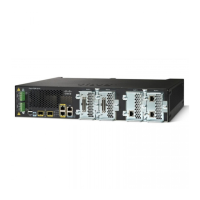37-14
Catalyst 3550 Multilayer Switch Software Configuration Guide
78-11194-09
Chapter37 Troubleshooting
Diagnosing Connectivity Problems
This example shows how to perform a traceroute to an IP host:
Switch# traceroute ip 171.9.15.10
Type escape sequence to abort.
Tracing the route to 171.69.115.10
1 172.2.52.1 0 msec 0 msec 4 msec
2 172.2.1.203 12 msec 8 msec 0 msec
3 171.9.16.6 4 msec 0 msec 0 msec
4 171.9.4.5 0 msec 4 msec 0 msec
5 171.9.121.34 0 msec 4 msec 4 msec
6 171.9.15.9 120 msec 132 msec 128 msec
7 171.9.15.10 132 msec 128 msec 128 msec
Switch#
The display shows the hop count, IP address of the router, and the round-trip time in milliseconds for
each of the three probes that are sent.
To terminate a trace in progress, enter the escape sequence (Ctrl-^ X by default). You enter the default
by simultaneously pressing and releasing the Ctrl, Shift, and 6 keys, and then pressing the X key.
Using Layer 2 Traceroute
This section describes this information:
• Understanding Layer 2 Traceroute, page 37-14
• Usage Guidelines, page 37-15
• Displaying the Physical Path, page 37-16
Understanding Layer 2 Traceroute
The Layer 2 traceroute feature allows the switch to identify the physical path that a packet takes from a
source device to a destination device. Layer 2 traceroute supports only unicast source and destination
MAC addresses. It determines the path by using the MAC address tables of the switches in the path.
When the switch detects a device in the path that does not support Layer 2 traceroute, the switch
continues to send Layer 2 trace queries and lets them time out.
Table 37-2 Traceroute Output Display Characters
Character Description
* The probe timed out.
? Unknown packet type.
A Administratively unreachable. Usually, this output means that an access list is
blocking traffic.
H Host unreachable.
N Network unreachable.
P Protocol unreachable.
Q Source quench.
U Port unreachable.

